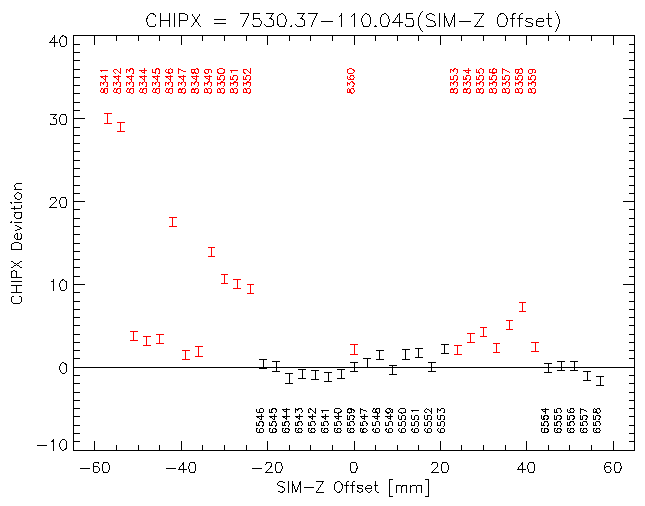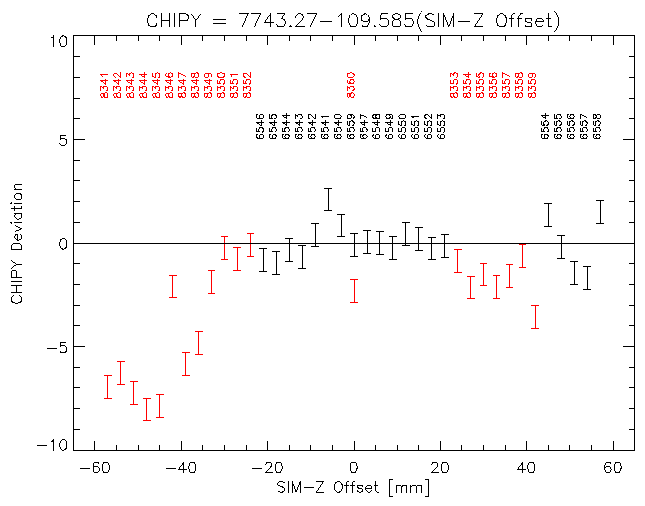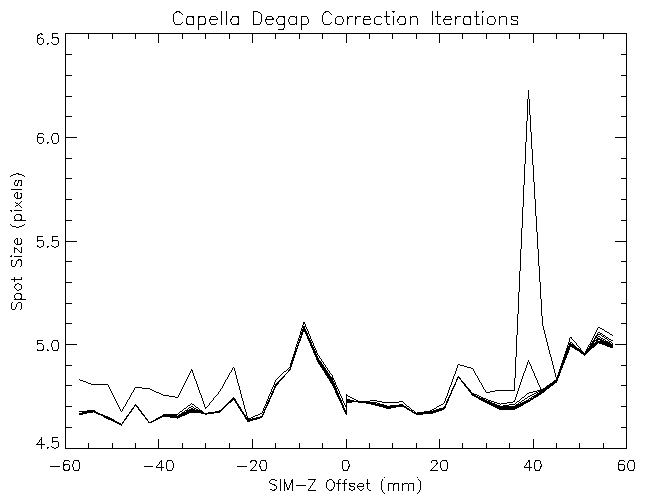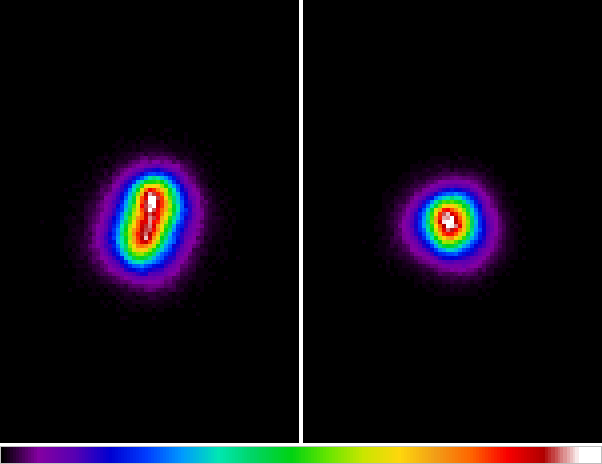HRC-I Degap Lookup from Capella Data - 2007
Summary
In this memo I describe the derivation of a new set of HRC-I degapping
corrections. These corrections were determined from the complete
set of Capella observations, performed at varying SIM translation
offsets during 2005 December to 2006 January and 2007 January. The
new corrections provide a major improvement in the CRSU = 12-13
region and smaller improvements elsewhere.
Introduction
In and earlier memo, HRC-I Degap Lookup
from Capella Data, I described an initial version of the
HRC-I degap lookup corrections derived from the 2005 December to
2006 January Capella observations. These corrections provided
updates in the central portion of the HRC-I and in a corner
where observations of bright sources had been performed in order
to limit the dose to the central region. These observations were
also used to determine the relative rotation of the HRC-I to the
SIM translation axis (HRC-I
Rotation Angle).
A goal in the earlier analysis was to avoid using the observed
location of the events in the detector in making the predictions
of where the events should appear. The known celestial position
of Capella was used with the aspect solution to make a
prediction of where the aim-point fell on the
detector. Unfortunately, this goal could not be maintained with
the inclusion of the 2007 January data. As shown in
figure 1, when the SIM-Z offset goes negative there are
large deviations in the observed position from where we expect
based on the aspect solution. A likely origin for the deviation
is in the reconstruction of the detector location with respect
to the aim-point using the fiducial lights; the light path may
be on different facets of the retroreflector/collimator.

|

|
| Figure 1: Deviations of the mean observed CHIP
positions from expectations given the known position of
Capella, the aspect solution, and the previously
determined orientation of the HRC-I on the SIM. ObsIDs
of the observations are indicated. The red points are
the 2007 January data.
|
Given this set-back an alternative approach of using the observed
mean location of source events in predicting the expected
detector locations, deriving updated degap corrections and
applying them, and iterating was developed.
Reduction Steps
Much of the reduction follows that of the earlier proto-typing work
that is documented in HRC-I Degap
Lookup Table. The following is brief listing of the steps
used in each iteration.
- For each observation:
- Determine the mean SKY (x,y) position of the source
- Select events within an 8-pixel radius of the mean position
- Using the mean SKY position determine the mean offset from the
nominal on-axis position
- Using the mean offset position determined above and the nominal roll
angle of the observation (ROLL_NOM from the aspect file
header) determine the radial offset and position-angle of
the mean offset position
- Use the radial offset and position angle of the mean offset
position and the geometry that describes the alignment of
the HRC axes with the spacecraft to determine the location
relative to the nominal HRC U,V position for the nominal SIM-Z
position for the detector
- Adjust the U,V position determined above for any offset of the
SIM from its nominal translation position to determine the
location of the source relative to the nominal U,V position
- Use the time history of the RA and Dec in the aspect solution and
the nominal RA and Dec to determine a time history of the RA
and Dec offsets from the nominal direction.
- Use the time history of the Roll from the aspect solution and the
geometry that describes the alignment of the HRC axes with
the spacecraft to determine the time history of the rotation
of the RA and Dec offsets relative to the HRC axes
- Use the time histories of RA and Dec offsets and their rotation
angle relative to the HRC axes to determine the path of the
nominal pointing direction in HRC U,V
- Add the location of the source relative to the nominal U,V
position to the time history of the path of the nominal
pointing direction in HRC U,V to get the predicted source
location on the HRC
- Use the derived time history of the predicted source location on
the HRC to determine the U,V for the time of each of the
selected events
- Combining the events from all the observations
- Sort events based on their AMP_SF, CRSU (or CRSV), and predicted
U (or V) position and for each AMP_SF, CRSU[V], U[V]
collection determine the mean RAW position, RAWX[Y], and
deviation of the mean RAW position from the integerized,
predicted position
- For a given CRS position and AMP_SF range select the predicted
position bins that lie in the nominal CRS position range
and which have more that a specified minimum number of
events (minimum number = 5)
- From the selected predicted position bins use the mean RAW
position at each bin and the mean deviation of the RAW
position from the predicted position, smooth over a
specified number of samples in the RAW position (smoothing
number = 5), and interpolate the correction into integer
RAW position bins within the nominal CRS position range
- If there are inadequate statistics or coverage for the
CRS-position/AMP_SF combination use the existing correction
- At low and high CRS position the statistics on AMP_SF = 3 are
low. If the AMP_SF = 1 and 2 corrections are different from the
prior version but the AMP_SF = 3 are not then update the
AMP_SF = 3 correction with the average of the AMP_SF 1 and 2
corrections.
The updated degapping corrections from these steps were used to
re-process the Capella observations and then the steps repeated. A
total of ten iterations were performed. Figure 2 shows the
evolution of a measure of the size of the source at the various
SIM_Z offsets as the iterations proceeded. The size was determined
by first finding the best center via iteratively-clipped
centroiding, using dmstat to calculate the standard deviation in x
and y of the events within a 20-pixel radius of that center, and
taking the square-root of the sum of their squares. The large peak
in the initial iteration at a SIM-Z offset of ~40 mm was due
to a particularly bad set of corrections around
CRSU&nbps;=&nbps;12 that we have unknowingly been using since the
start of the mission. The poor degap correction is evident in the
initial processing ObsID 8358, which shows a jet-like
extension; the GO ObsID 8225 is similarly affected. Most of
the size improvement occurs within the first two or three
iterations; however, there is an overall continuing small
improvement with additional iterations. The reason for the larger
size in the SIM-Z Offset ranges of -15 — -5 mm and
50 — 60 mm is not clear at this time.

|
| Figure 2: Size of Capella image for various SIM-Z
offsets with iterations of derived degapping corrections.
|
The degap corrections from the tenth iteration are available at
Performance Examples
In order to evaluate the performance of the degap correction updates I
have re-processed our long AR Lac observation, ObsID 1385, with
each of the iterations, starting with the current version of the
degap lookup. Table 1 lists measures of the source size with
as a function of the iteration of the degap correction.
Table 1: ObsID 1385 Source Size
| Iteration | X stddev | Y stddev | Radial
Size |
|---|
| 0 | 3.3108 | 3.1590 | 4.5761 |
| 1 | 3.2927 | 3.1572 | 4.5617 |
| 2 | 3.2872 | 3.1579 | 4.5583 |
| 3 | 3.2778 | 3.1622 | 4.5545 |
| 4 | 3.2737 | 3.1634 | 4.5524 |
| 5 | 3.2744 | 3.1672 | 4.5555 |
| 6 | 3.2718 | 3.1670 | 4.5535 |
| 7 | 3.2735 | 3.1718 | 4.5581 |
| 8 | 3.2711 | 3.1737 | 4.5577 |
| 9 | 3.2741 | 3.1751 | 4.5608 |
| 10 | 3.2728 | 3.1738 | 4.5590 |
There is a slight overall improvement from the current degap
correction (iteration 0) using any of the iterations; although
the differences are at a small fraction of an HRC pixel. The best
radial size result comes with iteration 4 and iterations 8 and 3
produce the smallest standard deviations for the X and Y,
respectively.
ObsID 8225 provides a more significant example of the improvement the
updated degapping corrections provide. ObsID 8225, one of a
series of observations of Cyg X-2, was strongly affected by the
poor degapping corrections around
CRSU = 12. Figure 3 shows a comparison of an
image of the source using the current degap lookup
(hrciD1999-07-22gaplookupN0002.fits) and using iteration 10. The
improvement is obvious.

|
| Figure 3: ObsID 8225, Cyg X-2, image comparison of
processing with the (left) original degap correction,
hrciD1999-07-22gaplookupN0002.fits and (right) updated
corrections.
|
Table 2 below lists the radial size as a function of the degapping
correction iteration. After the first couple of iterations the
improvement is at the level of a small fraction of an HRC pixel.
Table 2: ObsID 8225 Source Size
| Iteration | Radial Size |
|---|
| 0 | 8.5650 |
| 1 | 7.5312 |
| 2 | 7.3496 |
| 3 | 7.2893 |
| 4 | 7.2510 |
| 5 | 7.2264 |
| 6 | 7.2108 |
| 7 | 7.2007 |
| 8 | 7.1915 |
| 9 | 7.1844 |
| 10 | 7.1850 |
Last modified: Fri Jul 6 15:45:18 EDT 2007
Dr. Michael Juda
Harvard-Smithsonian Center for Astrophysics
60 Garden Street, Mail Stop 70
Cambridge, MA 02138, USA
Ph.: (617) 495-7062
Fax: (617) 495-7356
E-mail: mjuda@cfa.harvard.edu



